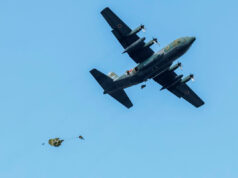The Sentinel is an airborne battlefield and ground surveillance aircraft based on the Bombardier Global Express ultra long range business jet and serves a role similar to JSTARS with the RAF, the jet was adapted by Raytheon to meet the RAF’s requirements.
Sentinel was originally known as the ASTOR (Airborne STand-Off Radar) programme. The ASTOR program can be traced to
the Corps Airborne Stand-Off Radar (CASTOR) concept.
Between 1983 and 1985, the Ministry of Defence evaluated two approaches to the CASTOR concept: a high-and-fast solution using SAR technology on board a Canberra, and a low-and-slow
solution using advanced multimode conventional radar on board a Defender aircraft.
The high-altitude SAR/MTI solution would provide the RAF with a
means of locating targets in enemy rear areas. It would have a dual capability – a primary mapping mode and a secondary MTI mode. The low-altitude MTI solution was favored by the Army and would have been configured to provide a primary MTI mode supported by a secondary mapping mode.
Though fully developed and immediately available, JSTARS aircraft, as originally offered, fell short of the specified ASTOR requirements in several areas. The JSTARS Boeing 707 cannot reach the specified altitude of 50,000ft; its maximum altitude is 42,000ft (Northrop Grumman officials, however, noted that
JSTARS could perform the ASTOR’s surveillance functions without reaching the specified according to reports on the Sentinel acquisition process).
Raytheon was announced as the preferred contractor in June 1999. The final contract, worth more than $1.3 billion, called for five ASTOR systems to enter service between 2005 and 2006. The system would consist of Raytheon’s Advanced Synthetic Aperture
Radar II mounted on twin-engine Global Express business jets by Canada’s Bombardier. The contract also called for eight ground stations, to be produced by Motorola.
In 2010 the government’s Strategic Defence and Security Review announced plans to “withdraw the Sentinel airborne ground surveillance aircraft once it is no longer required to support operations in Afghanistan”. The 2010 decision was reversed in 2014 by Prime Minister David Cameron and in the 2015 SDSR, the British government announced that the type’s retirement would be delayed and that it would remain in service “into the next decade”.
In the words of the Royal Air Force, the Sentinel R.Mk 1 provides “long-range, wide-area battlefield surveillance, delivering critical intelligence and target tracking information” to British and coalition forces.
The aircraft has been operationally deployed in support of operations in Afghanistan, Libya and Mali, and is currently deployed in support of British and Coalition operations in Iraq and Syria.
“Using its powerful multi-mode radar, the Sentinel’s mission crew identifies, tracks and images numerous targets over great ranges, passing the information in near real time to friendly forces.
A team of intelligence imagery analysts from 1 Intelligence, Surveillance, Reconnaissance (ISR) Wing backs up the Sentinel crews, conducting in-depth forensic analysis of collected data, and using it to generate intelligence products for time-critical dissemination to commanders and decision makers, enabling them to execute current operations and plan future strategies.”
The main value of Sentinel is its ability to provide commanders with an overall battlefield display. Both enemy targets and
friendly forces (stationary and mobile) are identified and tracked to provide a comprehensive overview.
Sentinel operates in three modes: spotlight SAR, with 5-meter resolution for small-area surveillance of fixed targets; swath SAR, which provides large-area surveillance of fixed targets; and large-area surveillance of moving targets (including helicopters) travelling at a minimum of 10 kmph.
The system’s operating altitude is between 12,802 metres and 15,200 metres. From this height, its radar sensors are able to detect targets at a range of up to 300 kilometres (186.4 miles).
Aside from battlefield scenarios, Sentinel can be used to monitor natural disasters, pollution, and smuggling activities.













High value target, considering the personnel aboard.
Used to work only if it had its line of sight ground segment nearby. Do we know if they’ve finally got the broadband satellite link to work? Not a real strategic deplorable asset without it.
Surely Sentinel has a satcom downlink?
A nod’s as good as a downlink…..
deplorable asset ? It can’t be that bad ! 🙂
Ground segment is long gone!
A nod’s as good as a downlink…..